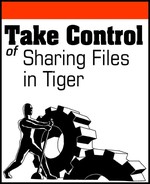Now that I’ve discussed mounting servers, it’s time to discuss dismounting them. At some point, you will want to remove the server or servers sitting on your Desktop. Servers can slow your system if the network is slow or becomes unavailable. You may notice this when a server window’s list of files tries to refresh and produces a spinning rainbow pointer.
If you dismount servers before putting your computer to sleep, you can reduce delays at wake-up time when Tiger might try to search for those servers. However, when you shut down your computer, Tiger automatically dismounts servers before powering off. You can also dismount a server from Tiger by carrying out one of the following actions:
Drag the volume icon in the Desktop, and notice that the Trash icon on the Dock temporarily changes to an Eject button while you drag. Then, drop the icon on the Eject button.
Control-click the volume on the Desktop and choose Eject “Volume Name” from the contextual menu.
Select the volume and press Command-E.
Select the volume and choose File > Eject “Volume Name”.
In the sidebar, click the Eject button next to the volume’s name.
Select the volume in the sidebar, and from the pop-up Action menu (it has a gear icon) at the top of the Finder window, choose Eject “Volume Name”.
